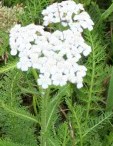 Common yarrow, also known as milfoil, is a rhizomateous herbaceous perennial native to the temperate regions of the Northern Hemisphere Asia, Europe and North America where it grows in open areas such as along roadsides, abandon lots and lawns. The species is considered weedy and invasive in many places but many cultivars and hybrids are valued garden plants and well worth growing. It is a member of the aster family, Asteraceae, that also includes daisies, goldenrod, and lettuce. The narrow dark green leaves are up to eight inches long, two to three times pinnately divided, feathery, aromatic, and mat-forming. In early summer flowering stems arise carrying two-four inch wide convex corymbs of quarter inch flowerheads over a long bloom time. The flowerheads of the species are usually white but can be pink or red. The flowerheads of cultivars and hybrids, however, may be shades of pink, red, lavender, peach, salmon, yellow or bicolors. In addition, the corymbs of cultivars and hybrids are larger and the stems taller and more upright than the species. Flower stalks of common yarrow may be weak when grown where night temperatures are above 70 F. Tolerant of heat and humidity but not wind. All common yarrows are good in fresh and dried arrangements. The genus name, Achillea, refers to Achilles the Trojan War hero of Greek mythology who used the plant to heal the wounds of his soldiers. The specific epithet, millefolium, comes from the Latin words mille meaning thousand, and folium meaning leaf, referring the highly divided foliage of the plant.
Common yarrow, also known as milfoil, is a rhizomateous herbaceous perennial native to the temperate regions of the Northern Hemisphere Asia, Europe and North America where it grows in open areas such as along roadsides, abandon lots and lawns. The species is considered weedy and invasive in many places but many cultivars and hybrids are valued garden plants and well worth growing. It is a member of the aster family, Asteraceae, that also includes daisies, goldenrod, and lettuce. The narrow dark green leaves are up to eight inches long, two to three times pinnately divided, feathery, aromatic, and mat-forming. In early summer flowering stems arise carrying two-four inch wide convex corymbs of quarter inch flowerheads over a long bloom time. The flowerheads of the species are usually white but can be pink or red. The flowerheads of cultivars and hybrids, however, may be shades of pink, red, lavender, peach, salmon, yellow or bicolors. In addition, the corymbs of cultivars and hybrids are larger and the stems taller and more upright than the species. Flower stalks of common yarrow may be weak when grown where night temperatures are above 70 F. Tolerant of heat and humidity but not wind. All common yarrows are good in fresh and dried arrangements. The genus name, Achillea, refers to Achilles the Trojan War hero of Greek mythology who used the plant to heal the wounds of his soldiers. The specific epithet, millefolium, comes from the Latin words mille meaning thousand, and folium meaning leaf, referring the highly divided foliage of the plant.
Type: Herbaceous perennial
Bloom: Two-four inch wide convex corymbs of quarter inch flowerheads beginning from early summer to fall; flowerheads of the species are usually white but can be pink or red. The flowerheads of cultivars and hybrids, however, may be shades of pink, red, lavender, peach, salmon, yellow or bicolors.
Size: 1-2’ H x 5’ W
Light: Full sun
Soil: Average to lean, medium moist to dry, well-drained
Hardiness: Zones 3-9
Care: Check invasiveness as necessary; cut back in spring to reduce overall height or cut back after initial bloom to encourage more blooming.
Pests and Diseases: Generally healthy but susceptible to stem rot, rust , and powdery mildew.
Propagation: Division of cultivars and hybrids (seed does not come reliably true)
Companion Plants: Day lily, sea holly, ornamental grasses